Internet Reactor Laboratory
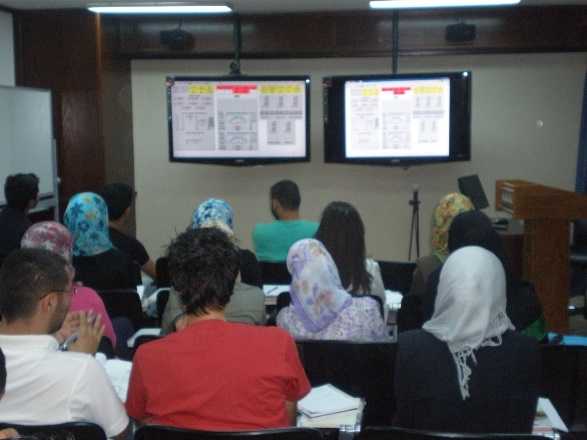
Internet Reactor Laboratory
Internet Reactor Laboratories are available to external academic institutions who wish to utilize the PULSTAR in demonstrating nuclear reactor operations and kinetics for their students. This capability enriches academic programs at universities without research reactors of their own, and may be used to expand the educational opportunities for nuclear engineering students throughout the United States and internationally. Upgraded Internet Reactor Laboratory (IRL) infrastructure has been installed and is currently available for use at the PULSTAR reactor of the Nuclear Reactor Program (NRP) at North Carolina State University (NCSU).
In 2016, the United States and the Republic of Vietnam entered into an Administrative Arrangement under Section 123 of the Atomic Energy Act, with a goal of enhancing nuclear training and education for Vietnamese engineering students. Funding was provided by the DOE to upgrade the PULSTAR IRL infrastructure to “second generation” state-of-the-art remote data acquisition and video teleconferencing capabilities supporting content sharing across multiple remote user platforms. The goal was to provide a realistic laboratory experience to remote students, allowing them to interact with the PULSTAR reactor operators and view, record, and process live reactor data in real time. In designing the upgraded systems, the following functional objectives were set: 1) provide robust, easy-to-use, graphical user interfaces allowing students to stream, observe and record reactor channel output data in real time; 2) provide customized GUIs for each laboratory module focusing on relevant channels and linking to supporting documentation and schematics; and 3) provide video teleconferencing capabilities supporting content sharing across multiple remote user platforms including tablets and smartphones. Installation of the upgraded IRL hardware and software platforms were completed and commissioned in 2018.
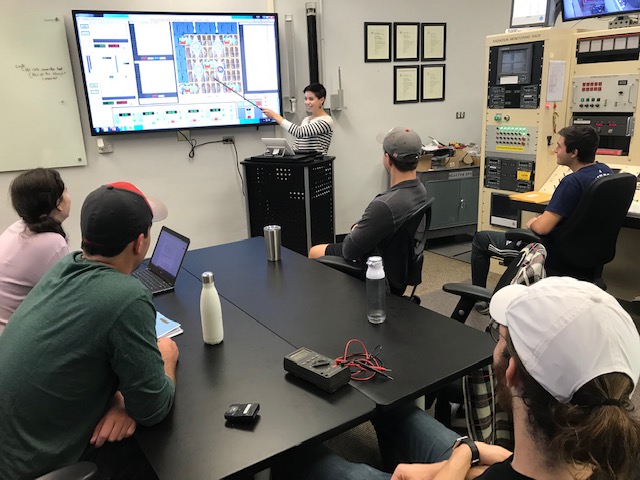
The current IRL system is comprised of a Cisco Telepresence video conferencing unit and a LabView based reactor data acquisition system. The LabView system allows up to 100 remote student clients to login securely to the local data acquisition server and provides 130 channels of live reactor output telemetry displayed in GUIs customized for each laboratory session. Reactor control functions are not connected to the system, and encrypted single use logon credentials are issued for each lab session, ensuring that robust cyber security protections are maintained. During IRL sessions, remote students may interact with the control room staff via the Telepresence system using their mobile device or PC, and view live reactor telemetry via the remote client LabView application while recording the data for subsequent review and analysis.
IRL System Hardware
The Cisco Telepresence system is capable of connecting to remote sites using multiple platforms. This functionally diverse platform is useful in providing a variety of options when connecting to remote sites which may have limited teleconferencing infrastructure. Two high definition pan-tilt-zoom (PTZ) cameras mounted in the control room along with audio equipment provide for live interaction between the remote site and the PULSTAR reactor staff. The cameras, local 65” and 75” touch screen displays and a graphics PC are connected to a Touch Tablet, which allows a presenter to control and display video and graphical laboratory content locally and remotely.
National Instruments (NI) data acquisition system hardware interfaces with LabView software provides the digital user interface. The NI data acquisition modules accept optically isolated digital, analog, and thermocouple inputs from the reactor control, monitoring, and experimental systems. 78 digital inputs monitor the discrete ON/OFF states of reactor instrumentation such as coolant pumps, control rod limit switches, channel annunciators and alarms, and SCRAM signals. 42 analog inputs monitor continuous signal outputs of channels such as reactor power level, control rod height, coolant flow rate, coolant system temperatures, and in-core miniature fission chamber output. Ten thermocouple inputs are connected to K-type temperature sensors which may be inserted into the fuel coolant channels to measure distributed in-core temperature profiles.
IRL System Software – Graphical User Interface
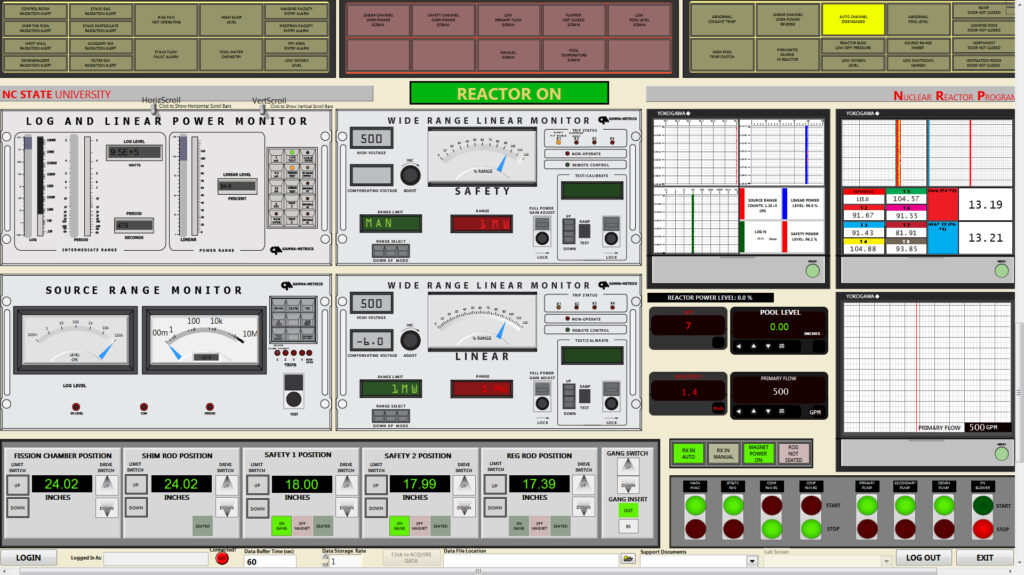
The NI hardware interface input cards described above are connected to a customized LabView data acquisition system running on a local Windows PC based server. The remote student user downloads a LabView data acquisition executable file from cloud-based storage and installs it on their computer. For each IRL session, remote students are provided with unique credentials allowing secure encrypted connection to the server. Once logged in, the student’s application connects to the local data acquisition server and streams the live reactor telemetry to their desktop. The LabView application GUI have been designed to display live reactor telemetry represented by realistic depictions of instrumentation installed in the reactor console (see figure above). Students can view, record and process the data live on their remote computer, just as they would if they were participating in a laboratory session on site.
Additional GUIs have been customized with graphics to support specific laboratory sessions, and have supporting content integrated such as schematics and drawings that illustrate associated technical details and concepts. Examples of integrate supporting content include a 3D facility model, a fuel assembly diagram (see figure below), a control rod diagram, a cooling system schematic with live temperature telemetry, and a reactor facility elevation view. Following the completion of each IRL session, the remote student has the ability to process and analyze the reactor telemetry data they have recorded.
Internet Reactor Laboratory Sessions
A selection of nine different remote internet reactor laboratory sessions are offered which are identical in nature to those provided to nuclear engineering students on site at N.C. State University. IRL sessions offered include:
- Introduction to Reactor Systems: Utilizing the main console GUI and supporting content, students are introduced to the reactor plant systems. Reactor core components and configuration, reactor safety channels with console instrumentation, SCRAM logic and safety interlocks, reactor coolant systems, radiological safety systems and experimental systems are all discussed. Presentation of system layouts is aided by reactor staff walking down the reactor facility systems while streaming live video and audio from a handheld device to the Telepresence system.
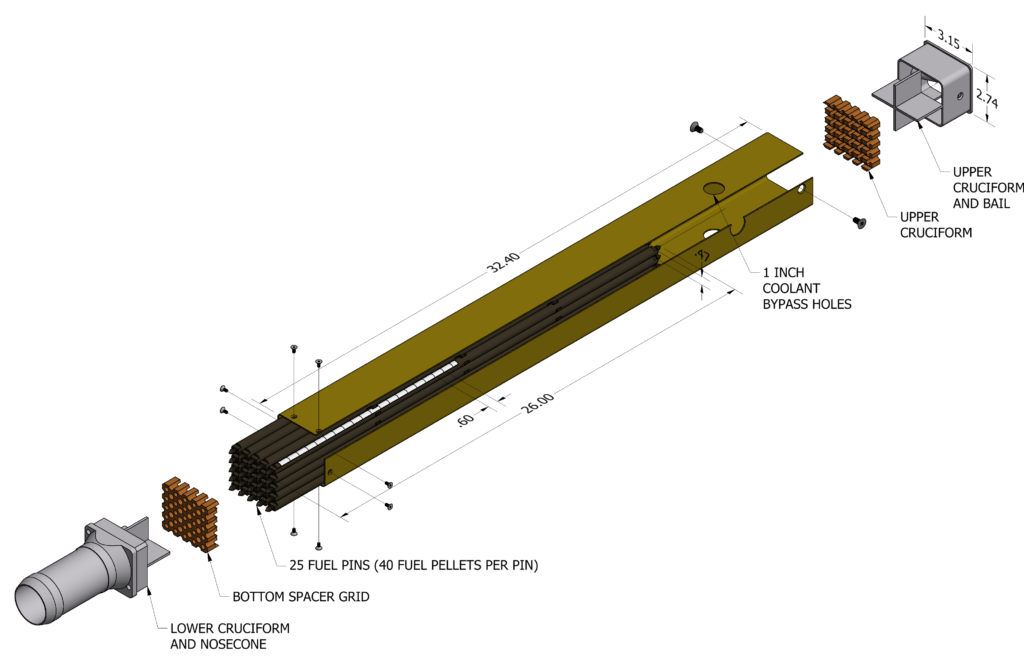
- 1/M Approach to Criticality: Utilizing a GUI detailing the startup range instrumentation and control rod positions, students take the reactor from shutdown to criticality utilizing a conservative 1/M startup methodology. Utilizing the count rate from the Source Range Monitor, students make conservative projections of the critical control rod height, iterating until criticality is achieved.
- Normal Reactor Startup and Power Range Operations: Starting with the reactor in a shutdown state, students compute an estimated critical rod position by performing a reactivity balance. The reactor is then brought to criticality at low power through following operations procedures and observing the characteristics of subcritical multiplication on the power monitoring channels presented on the main console GUI. The reactor is then raised to higher power levels, with students observing the response of instrumentation and temperature feedback characteristics.
- Control Rod Calibration: A reactor control rod is calibrated utilizing the constant period method. The reactor is brought critical at low power with the rod to be calibrated inserted. The rod is then withdrawn in steps, and students measure the power doubling times through observing the response of the Linear Power Channel via a customized laboratory GUI. Students then calculate the reactor period for each step and plot the differential and integral rod worth curves as a function of control rod height.
- Axial Flux Measurement: A miniature in-core (MIC) fission chamber neutron detector is inserted in a dry well placed inside a PULSTAR fuel assembly coolant channel. The reactor is operated at low power while the detector is slowly withdrawn along the axis of the cooling channel, measuring the neutron flux profile as a function of core height (see trace in Figure 6 at right). This measurement is repeated for five fuel assemblies in a row across the core to allow students to calculate the radial and axial core neutron flux distributions.
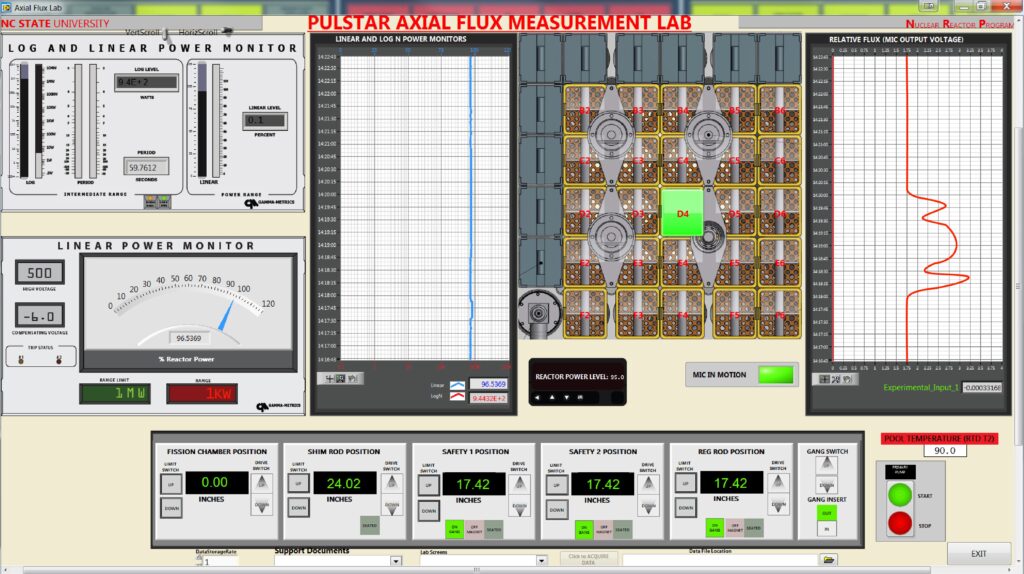
- Power Coefficient Measurement: The reactor power coefficient is measured dynamically through inserting a known amount of positive reactivity into the reactor from criticality at low power. The resulting power transient is observed and recorded utilizing the main console GUI. The time dependent power and moderator temperature data may then be then utilized by students to calculate the power coefficient of reactivity.
- Void Coefficient Measurement: The reactor is brought critical at low power and an empty dry well of known volume is placed inside a PULSTAR fuel assembly coolant channel to displace the moderator. The resulting change in reactivity is measured through observing reactor control rod height on the main console GUI and adjusting the control rods to maintain criticality. This measurement is repeated for five fuel assemblies in a row across the core to allow students to determine spatial dependency.
- Heat Balance Power Calibration: A heat balance is performed by bringing the reactor critical at several power levels ranging from 10% to 100% of full power. Students observe the primary coolant temperature and flow channel telemetry presented on the main console GUI (see Figure 5, temperature recorder at right). Temperature changes across the core and primary heat exchanger are measured at each power level and utilized to perform a heat balance calculation.
- Natural Circulation / Flow Reversal: Dry wells containing two thermocouples each (positioned at the top and bottom of the fuel) are inserted into five fuel assembly coolant channels located at the corners and center of the PULSTAR core. The reactor is operated at low power under forced downward primary flow cooling conditions and allowed to come to thermal equilibrium. The primary coolant pump is then tripped and core cooling flow coasts to a stop and then reverses as natural convection flow is established. Utilizing the natural circulation laboratory GUI (see Fig. 7), students observe and measure the coolant channel temperatures during steady state conditions and the flow reversal transient.
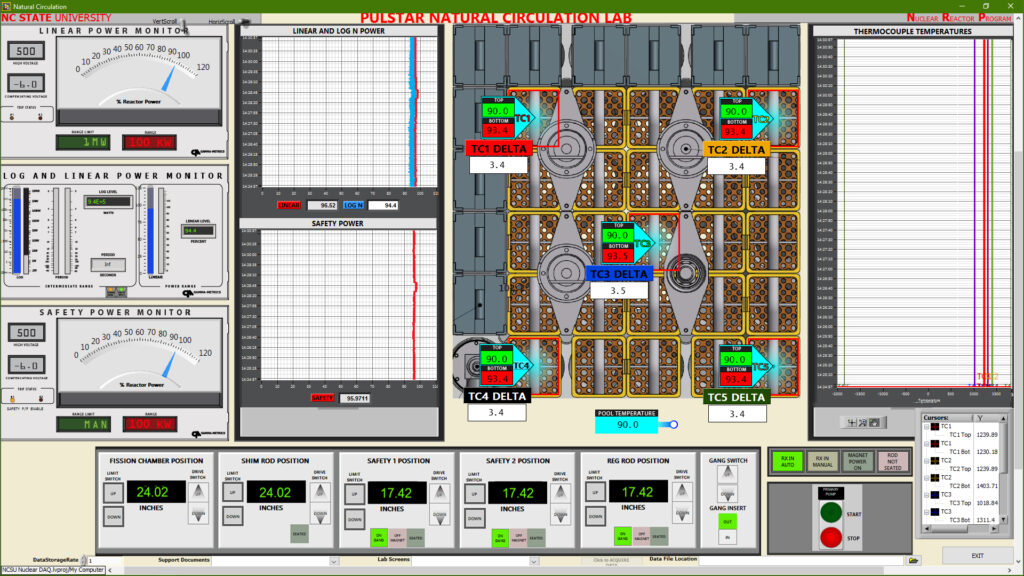
History of IRL at NC State
Since its initial criticality in 1972, the PULSTAR Reactor has been utilized to provide instructional and training content to nuclear engineers and reactor operators from academia and industry. Undergraduate students in the Department of Nuclear Engineering utilize the facility for reactor kinetics and thermal hydraulic academic laboratories, and frequently as the focus for senior design projects. The NE235 Nuclear Reactor Operations training course provides hand-on operations experience for undergraduates interested in becoming reactor operators, with several students earning NRC reactor operator licenses each year. Plant operators from local nuclear utilities utilized the facility through the late 1990’s to perform required operations training evolutions in support of their NRC approved requalification programs.
Under the DOE Innovations in Nuclear Infrastructure and Education (INIE) Program in 2002, N.C. State University was awarded a project to install distance learning capabilities at the PULSTAR Reactor with the intent of enriching educational experiences for nuclear engineering students at academic institutions without a research reactor of their own. The vision was to enable remote students to experience and participate in reactor laboratory sessions as if they were in the control room observing and taking data first-hand. An RTP Micro 2000 data acquisition system was utilized to provide remote distribution of 110 channels of live reactor telemetry. Remote users installed an executable file on their PC that established a real time network connection to the RTP server, and provided display of live reactor telemetry via the console GUI. A Polycom teleconferencing unit was installed in the PULSTAR control room with a PTZ camera and room microphone. This system allowed remote users to interact via a live feed with the facility operations staff, and remotely direct the camera to view console instrumentation and other content of interest.
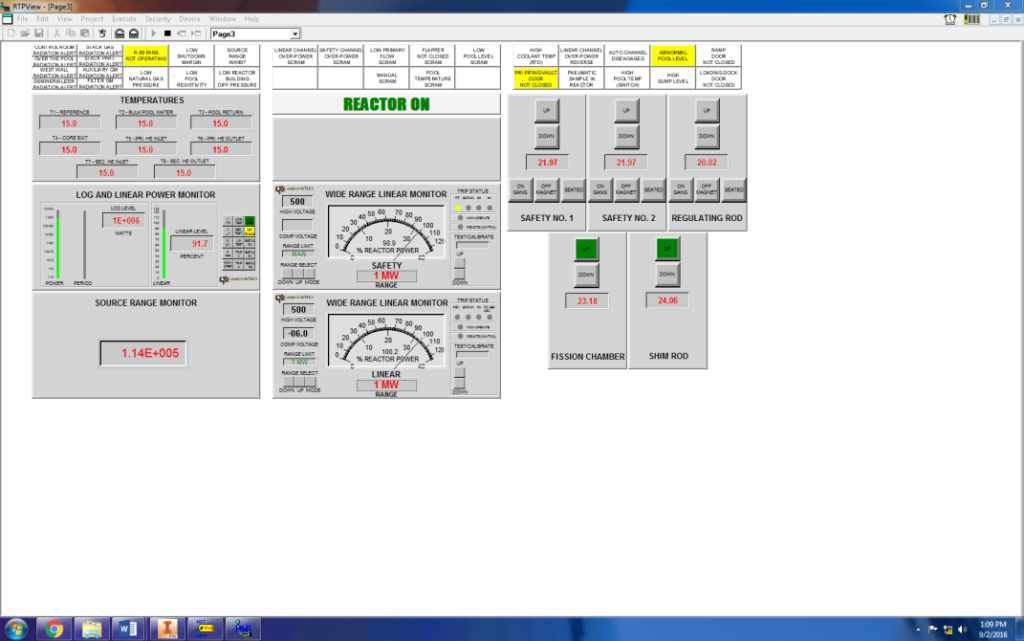
Starting in 2004, the system was utilized to provide IRL’s to nuclear engineering programs at the University of Tennessee at Knoxville, the Georgia Institute of Technology, the Jordan University of Science and Technology, and at workshops offered to utilities, government entities, and international organizations. Forty-five separate IRL sessions were provided during the period from 2004 through 2013 to hundreds of nuclear engineering students at these universities.